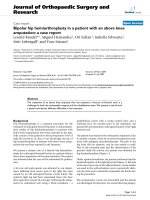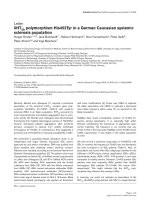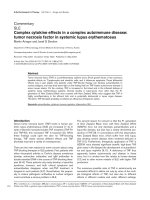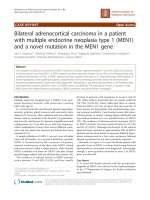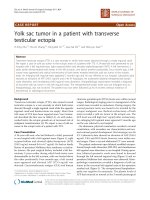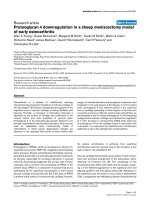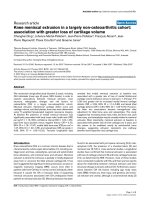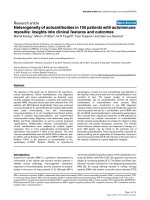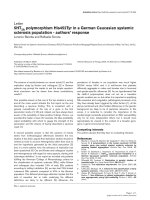Báo cáo y học: "Ectopic cervical thymoma in a patient with Myasthenia gravis" docx
Bạn đang xem bản rút gọn của tài liệu. Xem và tải ngay bản đầy đủ của tài liệu tại đây (1.52 MB, 3 trang )
CAS E REP O R T Open Access
Ectopic cervical thymoma in a patient with
Myasthenia gravis
Ti Hei Wu
1
, Jong Shiaw Jin
2
, Tsai Wang Huang
1
, Hung Chang
1
and Shih Chun Lee
1*
Abstract
Ectopic cervical thymoma is rare and is often misdiagnosed as a thyroid tumor or other malig nancy. Ectopic
thymic tissue can be found along the entire thymic descent path during embryogenesis. However, a thymoma
arising from such ectopic thymic tissue is extremely rare. Herein we report a patient with ectopic cervical thymoma
and myasthenia gravis (MG) and discuss the management.
Background
Ectopic cervical thymomas are very rare and often pre-
sent as palpable neck masses. Ectopic cervical thymoma
presenting in patients with MG is even rarer a nd only
two other cases have been reported in the literature
[1,2]. The diagnosis is very difficult t o make and has a
major diagnostic pitfall. Extended thymectomy offered a
good result for these patients. Herein we present a case
of ectopic cervical thymoma associated with MG.
Case report
A 58-year-old woman presented to our Neurology
department with ptosis that had persisted for 4 months.
A physical examination revealed a palpable cervical
mass. Repetitive nerve stimulation testing revealed
abnormally decreasing responses and the acetylcholine
receptor antibody titer in the patient’ sserumwasele-
vated ( 8.6 nmol/L, normal <0.2 nmol/L). Other l abora-
tory examinations were unremarkable, including thyroid
function tests and tests for autoimmune diseases. She
was diagnosed with MG and received pyridostigmine
treatment (180 mg/day). Computed tomography (CT) of
her chest revealed one well- circumscribed, homoge-
neous mass of soft tissue measuring 2.6 × 2.5 × 1.6 cm
at the lower pole of the left thyroid gland (Figure 1).
The fat plane between the thyroid gland and the tumor
was clear. The patient w as subsequently referred to our
thoracic surgery department and underwent extended
transcervical thymomectomy and transsternal
thymectomy. A well-encapsulated soft multi-lobulated
tumor measuring 3 × 3 × 1.5 cm was found separately
fromthethoracicthymicgland,locatedbetweenthe
upper pole of the left thymus gland and lower pole of
the left thyroid gland (Figure 2). The cut surface of the
tumor was tan-colored with no areas of necrosis. A total
of 40 gm of thymic tissue was removed additionally.
The anatomopathological examination of the sample
using optical microscopy and immunohistochemical
tests confirmed the diagnosis of an ectopic thymoma
(Figure 3). The microscopy demonstrated the tum or
comprised a mixture of lymphocyte-poor spindle cell
areas and lymphocyte-rich areas. These histopathologic
findings were consistent with a type AB according to
World Health Organization Classification System
(WHO), Masaoka stage I. The postoperative course was
uneventful and the patient was discharged seven days
after the operation. The patient was in complete remis-
sion at a three-month follow-up, and pharmacologic
remission at a six-month follow-up.
Discussion
The thymus is a lymphoepithelial organ that is derived
embryologically from the third and fourth pharyngeal
pouches, which descend to the anterior mediastinum in
the sixth week of human gestation. Aberrant migration
or remnants might occur along the entire path of thy-
mic descent, and up to 20% of individuals are found to
have these aberrant features [3]. Thymomas arising from
aberrant thymic tissue are extremely rare, and the inci-
dence of ectopic cervical thymoma is unknown. To the
best of our knowledge, fewer than 30 cases of ectopic
cervical thymoma have been published in the literature
* Correspondence:
1
Division of Thoracic Surgery, Department of Surgery, Tri-Service General
Hospital, National Defense Medical Center, Taipei, Taiwan
Full list of author information is available at the end of the article
Wu et al. Journal of Cardiothoracic Surgery 2011, 6:89
/>© 2011 Wu et al; licensee BioMed Central Ltd. This is an Open Access article distributed under the terms of the Creative Commons
Attribution License ( s/by/2.0), which permits unrestricted use, distribution, and reproduction in
any medium, provided the original work is properly cited.
[1,4-17]. As mediastinal tumors, WHO type AB repre-
sent the most common subtype of ectopic cervical thy-
momas [5].
Patients with m ediastinal thymomas are often clini-
cally asymptomatic (50%-60%) or p resent as local symp-
toms (30% to 40%) or associated systemic parathymic
disease syndromes (30% to 50%). When there are local
symptoms, vague chest pain, shortness of breath, and
cough are the common complaints. When there are sys-
temic parathymic disease syndromes, MG is the most
comm only associated disease (30%-50%) [18]. Relatively,
ectopic cervical thymomas most commonly present as
palpable neck masses and are misdiagnosed as thyroid
masses. Only two other patients in the literature have
presented with MG as the symptom [1,2]. The diagnosis
of an ectopic cervic al thymoma is very difficult to make
and has a major diagnostic pitfall. As mentioned above,
most patients present with a palpable neck mass and are
mis diagnosed as having thyroid tumors. Further pathol-
ogy, such as fine needle aspiration cytology, is needed to
establish the nature of the so-called ‘’thyroid tumor’’.
Because the thymus gland is compo sed of epithelial and
lymphoid elements, it could be misdiagnosed as a squa-
mous cell carcinoma or lymphoma [7, 10]. In our case,
the patient presented with MG and the chest CT scan
showed a clear fat plane between the cervical mass and
the thyroid gland, which suggested that the cervica l
mass was separate from the thyroid. Therefore we
thought the cervical mass was an ectopic thymoma and
avoided tissue biopsy, opting for surgery.
Most ectopic cervical thymomas misdiagnosed as thyr-
oid tumors were removed simply by a neck incision,
because the exact diagnosis was made after postopera-
tive histopathology. For ectopic cervical thymomas with
MG, extended thymectomy seems to be the treatment
of c hoice, like mediastinal thymomas. Of the two other
case reports of ectopic cervical thymoma with MG in
the literature, one received extended thymectomy and
the other received simple resection of the ectopic cervi-
cal thymoma. The one received extended thymectomy
achieved complete remission and the one received sim-
ple resection of the ectopic cervical thymoma achieved
pharmacological remission during the long-term follow-
up. Although our patient achieve d only pharmacologic
remission at a six-month follow-up, but the outcome of
extended thymectomy improved gradually and took 3
years to achieve plateau [19]. Long-term follow-up of
our patient is requir ed to confirm the result more pre-
cisely. Overall, the outcomes of thymectomies for
patients with MG and an ectopic cervical thymoma
were good.
For ectopic thymo mas with capsule invasion, adjuv ant
radiotherapy may be considered to reduce local
Figure 1 Contrast-e nhanced computed tomography of the
chest showed a tumor mass (black arrow) at the lower pole of
the left thyroid gland (white arrow). The fat plane (arrowhead)
between the thyroid gland and the tumor was clear.
Figure 2 Photography of transcervical thymomectomy
illustrating one well-encapsulated tumor located between the
upper pole of the left thymus gland and lower pole of the left
thyroid gland.
Figure 3 Photomicrography s (hematoxylin and eosin staining).
(A) Lobules separated by thick fibrous bands (× 40). (B) Microscopic
findings of transition between lymphocyte-rich area and the
lymphocyte-poor oval or spindle-shaped epithelial cell components,
compatible with a WHO type AB thymoma (× 400).
Wu et al. Journal of Cardiothoracic Surgery 2011, 6:89
/>Page 2 of 3
recurrence rates as the general rule in mediastinal thy-
momas. However, the number of patients i n this sub-
group was limited, so more cases co llection is required
to confirm the result.
Conclusion
Although the condition is rare, clinicians must bear in
mind that ectopic cervical thymomas might be asso-
ciated with MG. Extended thymectomy can offer a good
result for these patients.
Consent
Written informed consent was obtained from the patient
for publication of this case report and accompanying
images. A copy of the written consent is available for
review by the Editor-in-Chief of this journal.
Author details
1
Division of Thoracic Surgery, Department of Surgery, Tri-Service General
Hospital, National Defense Medical Center, Taipei, Taiwan.
2
Department of
Pathology, Tri-Service General Hospital, National Defense Medical Center,
Taipei, Taiwan.
Authors’ contributions
THW carried out the manuscript and collected references. JSJ reported
pathological findings and took the pathologic pictures. TWH and HC helped
to draft the manuscript. THW and SCL underwent this operation. All authors
read and approved the final manuscript.
Competing interests
The authors declare that they have no competing interests.
Received: 5 May 2011 Accepted: 6 July 2011 Published: 6 July 2011
References
1. Choi H, Koh SH, Park MH, Seung HK: Myasthenia gravis associated with
ectopic cervical thymoma. J Clin Neurosci 2008, 15:1393-1395.
2. Tommaso CM, Fausto B, Vito D’A: Myasthenia gravis, psychiatric
disturbances, idiopathic thrombocytopenic purpura and lichen planus
associated with cervical thymoma. J Thorac Cardiovasc Surg 1996,
111:486-487.
3. Jaretzki A, Steinglass KM, Sonett JR: Thymectomy in the management of
myasthenia gravis. Semin Neurol 2004, 24:49-62.
4. Oh YL, Ko YH, Ree HJ: Aspiration cytology of ectopic cervical thymoma
mimicking a thyroid mass. A case report. Acta Cytol 1998, 42:1167-1171.
5. Chan JK, Rosai J: Tumors of the neck showing thymic or related
branchial pouch differentiation: a unifying concept. Hum Pathol 1991,
22:349-367.
6. Gerhard R, Kanashiro EH, Kliemann CM, Juliano AG, Chammas MC: Fine-
needle aspiration biopsy of ectopic cervical spindle-cell thymoma: a
case report. Diagn Cytopathol 2005, 32:358-362.
7. Chang ST, Chuang SS: Ectopic cervical thymoma: a mimic of T-
lymphoblastic lymphoma. Pathol Res Pract 2003, 199:633-635.
8. Mende S, Moschopulos M, Marx A, Laeng RH: Ectopic micronodular
thymoma with lymphoid stroma. Virchows Arch 2004, 444:397-399.
9. Hsu IL, Wu MH, Lai WW, Lin MY, Chang JM, Yen YT, Tseng YL: Cervical
ectopic thymoma. J Thorac Cardiovasc Surg 2007, 133:1658-1659.
10. Mourra N, Duron F, Parc R, Flejou JF: Cervical ectopic thymoma: a
diagnostic pitfall on frozen section. Histopathology 2005, 46:583-585.
11. Ramdas A, Jacob SE, Varghese RG, Dasiah S, Rai R: Ectopic cervical
thymoma–the great mimic: a case report. Ind J Pathol Microbiol 2007,
50:553-555.
12. Bakshi J, Ghosh S, Pragache G, Vaiphei K, Gupta N: Ectopic cervical
thymoma in the submandibular region. J Otolaryngol 2005, 34:223-226.
13. Nagasawa K, Takahashi K, Hayashi T, Aburano T: Ectopic cervical thymoma:
MRI findings. AJR Am J Roentgenol 2004, 182:262-263.
14. Cohen JB, Troxell M, Kong CS, McDougall R: Ectopic intrathyroidal
thymoma: a case report and review. Thyroid 2003,
13:305-308.
15. Ponder TB, Collins BT, Bee CS, Silverberg AB, Grosso LE, Dunphy CH:
Diagnosis of cervical thymoma by fine needle aspiration biopsy with
flow cytometry. A case report. Acta Cytol 2002, 46:1129-1132.
16. Lanka KP, Sarin B, Prasad V, Sen S, Mehta A, Rawat HS, Mondal A, Sharma R:
Benign cervical thymoma masquerading as a malignant thyroid nodule.
Clin Nucl Med 2002, 27:862-864.
17. Rapoport A, Dias CF, De Freitas JP, De Souza RP: Cervical thymoma. Sao
Paulo Med J 1999, 117:132-135.
18. Thomas WS: Thymic tumors. In General thoracic surgery. Edited by: Thomas
WS. Philadelphia, US: Lippincott Williams 2009:2333-2334.
19. Masaoka A: Extended transsternal thymectomy. In General thoracic surgery.
Edited by: Thomas WS. Philadelphia, US: Lippincott Williams 2009:2302.
doi:10.1186/1749-8090-6-89
Cite this article as: Wu et al.: Ectopic cervical thymoma in a patient
with Myasthenia gravis. Journal of Cardiothoracic Surgery 2011 6:89.
Submit your next manuscript to BioMed Central
and take full advantage of:
• Convenient online submission
• Thorough peer review
• No space constraints or color figure charges
• Immediate publication on acceptance
• Inclusion in PubMed, CAS, Scopus and Google Scholar
• Research which is freely available for redistribution
Submit your manuscript at
www.biomedcentral.com/submit
Wu et al. Journal of Cardiothoracic Surgery 2011, 6:89
/>Page 3 of 3
